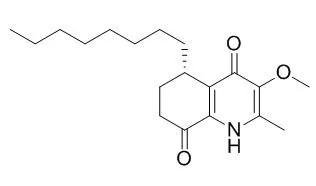| In vitro: |
| Int Immunopharmacol. 2017 Apr;45:34-42. | | Antidesmone, a unique tetrahydroquinoline alkaloid, prevents acute lung injury via regulating MAPK and NF-κB activities.[Pubmed: 28157559 ] | Acute lung injury, characterized by inflammation, is a main cause of respiratory failure that affects patients worldwide. Antidesmone is one compound mainly isolated from Ajugade cumbens Thunb (Labiatae), an herb agent of Labiatae family.
METHODS AND RESULTS:
In this research, we investigated the anti-inflammation effect of Antidesmone in vitro and in vivo. Antidesmone exerted none apparently cytotoxicity in vitro and toxic in vivo. In vitro results demonstrated that Antidesmone suppressed the excess inflammatory cytokines production, including tumor necrosis factor-α, interleukin-6 and interleukin-1β in lipopolysaccharide (LPS)-exposed RAW264.7 cells. In vivo results suggested that Antidesmone inhibited inflammatory cytokines in the bronchoalveolar lavage fluid and lung tissue after LPS stimulation. Moreover, Antidesmone attenuated the nuclear translocation of p65. Mechanism study revealed that mitogen-activated protein kinase (MAPK) and nuclear factor-kappa B (NF-κB) signaling pathways play important roles in Antidesmone's action.
CONCLUSIONS:
Taken together, our data uncover a relative toxic anti-inflammatory drug, Antidesmone, can inhibit inflammation on stimulated macrophages and thereby prevents acute lung injury by regulating MAPK and NF-κB signaling pathways. | | Pharm.Pharmacol.Lett.,2001,2:47-8. | | Antidesmone, a novel antitrypanosomal alkaloid.[Reference: WebLink] |
METHODS AND RESULTS:
Antidesmone, a novel acetogenic quinolone alkaloid from the African shrub Antidesma membranaceum, has been found to exhibit potent antitrypanosomal activity against Trypanasoma cruzi, the pathogenic agent of Chagas disease.
CONCLUSIONS:
The activity seems to be highly selective, being much larger than that towards other protozoan parasites causing tropical diseases. |
|
| In vivo: |
| Pestic Biochem Physiol. 2016 Nov;134:55-62. | | Evaluation of antidesmone alkaloid as a photosynthesis inhibitor.[Pubmed: 27914540] | Antidesmone, isolated from Waltheria brachypetala Turcz., owns special structural features as two α,β-unsaturated carbonyl groups and a side alkyl chain that can compete with the quinones involved in the pool of plastoquinones at photosystem II (PSII).
METHODS AND RESULTS:
In this work, we showed that the alkaloid is an inhibitor of Hill reaction and its target was located at the acceptor side of PSII. Studies of chlorophyll (Chl) a fluorescence showed a J-band that indicates direct action of Antidesmone in accumulation of QA- (reduced plastoquinone A) due to the electron transport blocked at the QB (plastoquinone B) level similar to DCMU. In vivo assays indicated that Antidesmone is a selective post-emergent herbicide probe at 300μM by reducing the biomass production of Physalis ixacarpa plants. Furthermore, Antidesmone also behaves as pre-emergent herbicide due to inhibit Physalis ixacarpa plant growth about 60%.
CONCLUSIONS:
Antidesmone, a natural product containing a 4(1H)-pyridones scaffold, will serve as a valuable tool in further development of a new class of herbicides. |
|






 Cell. 2018 Jan 11;172(1-2):249-261.e12. doi: 10.1016/j.cell.2017.12.019.IF=36.216(2019)
Cell. 2018 Jan 11;172(1-2):249-261.e12. doi: 10.1016/j.cell.2017.12.019.IF=36.216(2019) Cell Metab. 2020 Mar 3;31(3):534-548.e5. doi: 10.1016/j.cmet.2020.01.002.IF=22.415(2019)
Cell Metab. 2020 Mar 3;31(3):534-548.e5. doi: 10.1016/j.cmet.2020.01.002.IF=22.415(2019) Mol Cell. 2017 Nov 16;68(4):673-685.e6. doi: 10.1016/j.molcel.2017.10.022.IF=14.548(2019)
Mol Cell. 2017 Nov 16;68(4):673-685.e6. doi: 10.1016/j.molcel.2017.10.022.IF=14.548(2019)